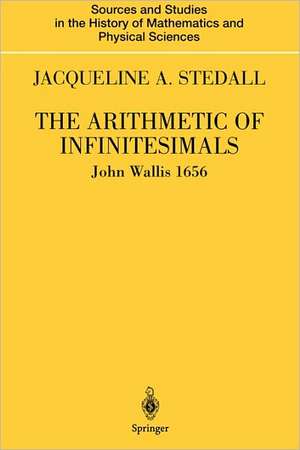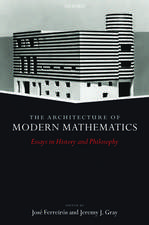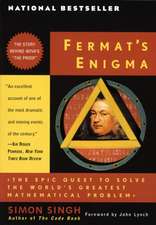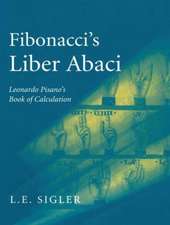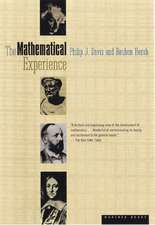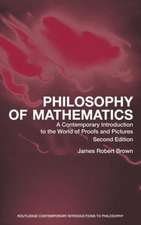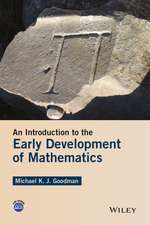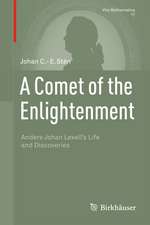The Arithmetic of Infinitesimals: Sources and Studies in the History of Mathematics and Physical Sciences
Autor John Wallis Introducere de Jacqueline A. Stedallen Limba Engleză Paperback – 29 noi 2010
| Toate formatele și edițiile | Preț | Express |
|---|---|---|
| Paperback (1) | 941.50 lei 6-8 săpt. | |
| Springer – 29 noi 2010 | 941.50 lei 6-8 săpt. | |
| Hardback (1) | 947.35 lei 6-8 săpt. | |
| Springer – 6 aug 2004 | 947.35 lei 6-8 săpt. |
Din seria Sources and Studies in the History of Mathematics and Physical Sciences
- 20%
 Preț: 756.13 lei
Preț: 756.13 lei - 18%
 Preț: 907.11 lei
Preț: 907.11 lei - 15%
 Preț: 667.86 lei
Preț: 667.86 lei - 18%
 Preț: 1434.29 lei
Preț: 1434.29 lei -
 Preț: 387.75 lei
Preț: 387.75 lei - 15%
 Preț: 638.57 lei
Preț: 638.57 lei - 18%
 Preț: 896.70 lei
Preț: 896.70 lei - 15%
 Preț: 643.65 lei
Preț: 643.65 lei - 18%
 Preț: 916.25 lei
Preț: 916.25 lei - 18%
 Preț: 1124.92 lei
Preț: 1124.92 lei - 18%
 Preț: 963.29 lei
Preț: 963.29 lei - 15%
 Preț: 652.31 lei
Preț: 652.31 lei - 18%
 Preț: 1244.89 lei
Preț: 1244.89 lei - 23%
 Preț: 686.57 lei
Preț: 686.57 lei - 15%
 Preț: 649.71 lei
Preț: 649.71 lei -
 Preț: 390.25 lei
Preț: 390.25 lei - 15%
 Preț: 644.18 lei
Preț: 644.18 lei - 15%
 Preț: 580.17 lei
Preț: 580.17 lei - 18%
 Preț: 1123.35 lei
Preț: 1123.35 lei - 15%
 Preț: 641.03 lei
Preț: 641.03 lei - 15%
 Preț: 581.14 lei
Preț: 581.14 lei - 18%
 Preț: 796.31 lei
Preț: 796.31 lei - 18%
 Preț: 2119.49 lei
Preț: 2119.49 lei - 24%
 Preț: 860.16 lei
Preț: 860.16 lei - 15%
 Preț: 645.14 lei
Preț: 645.14 lei -
 Preț: 384.48 lei
Preț: 384.48 lei - 18%
 Preț: 1410.63 lei
Preț: 1410.63 lei - 18%
 Preț: 969.28 lei
Preț: 969.28 lei - 15%
 Preț: 642.03 lei
Preț: 642.03 lei - 18%
 Preț: 1113.71 lei
Preț: 1113.71 lei - 15%
 Preț: 662.16 lei
Preț: 662.16 lei - 18%
 Preț: 963.29 lei
Preț: 963.29 lei - 15%
 Preț: 647.59 lei
Preț: 647.59 lei -
 Preț: 395.63 lei
Preț: 395.63 lei - 15%
 Preț: 709.56 lei
Preț: 709.56 lei - 18%
 Preț: 901.26 lei
Preț: 901.26 lei - 15%
 Preț: 695.53 lei
Preț: 695.53 lei - 24%
 Preț: 1294.90 lei
Preț: 1294.90 lei
Preț: 941.50 lei
Preț vechi: 1148.18 lei
-18% Nou
Puncte Express: 1412
Preț estimativ în valută:
180.15€ • 188.60$ • 149.07£
180.15€ • 188.60$ • 149.07£
Carte tipărită la comandă
Livrare economică 05-19 aprilie
Preluare comenzi: 021 569.72.76
Specificații
ISBN-13: 9781441919229
ISBN-10: 1441919228
Pagini: 232
Ilustrații: XXXIV, 192 p.
Dimensiuni: 155 x 235 x 12 mm
Greutate: 0.33 kg
Ediția:Softcover reprint of the original 1st ed. 2004
Editura: Springer
Colecția Springer
Seria Sources and Studies in the History of Mathematics and Physical Sciences
Locul publicării:New York, NY, United States
ISBN-10: 1441919228
Pagini: 232
Ilustrații: XXXIV, 192 p.
Dimensiuni: 155 x 235 x 12 mm
Greutate: 0.33 kg
Ediția:Softcover reprint of the original 1st ed. 2004
Editura: Springer
Colecția Springer
Seria Sources and Studies in the History of Mathematics and Physical Sciences
Locul publicării:New York, NY, United States
Public țintă
ResearchCuprins
To the most Distinguished and Worthy gentleman and most Skilled Mathematician, Dr William Oughtred, Rector of the church of Aldbury in the Country of Surrey.- To the Most Respected Gentleman Doctor William Oughtred, most widely famed amongst mathematicians, by John Wallis, Savilian Professor of Geometry at Oxford.- Doctor William Oughtred: A Response to the preceding letter (after the book went to press). In which he makes it known what he thought of that method.- The Arithmetic of Infinitesimals or a New Method of Inquiring into the Quadrature of Curves, and other more difficult mathematical problems.
Recenzii
From the reviews:
"John Wallis (1616-1703) was the most influential mathematician in England … . in his Arithmetica infinitorum (Arithmetic of Infinites), he extended traditional algebra of finite numbers and symbols … . The translator, Dr. Jacqueline Anne Stedall, has already accomplished important research on John Wallis and his mathematics and thus is ideally qualified for both the translation and a scholarly introduction and explanatory notes. She also supplies a glossary, a bibliography, and an index, while figures and tables are reproduced as facsimiles from the original edition." (Christoph J. Scriba, SIAM Review, Vol. 47 (2), 2005)
"The author has done a superb job with the translation and accompanying introduction. Her expertise with the subject is readily apparent. She has rendered a valuable service to the mathematical community with this English translation of Arithmetica infintorum. One can sense the anticipation and excitement Newton must have felt upon first reading the work." (James J. Tattersall, Mathematical Reviews, 2005e)
"Jackie Stedall is amazing. … here is her translation of John Wallis’s famous Arithmetic of Infinitesimals (Arithmetica Infinitorum, first published in 1656). Thank you, Jackie; please never stop. Wallis’s subtitle gives a good summary of what the book is about: ‘A New Method of Inquiring into the Quadrature of Curves, and other more difficult mathematical problems’. … Stedall’s translation gives us access once again to this fascinating book, and her introduction helps us understand its place in history. Not to be missed." (Fernando Q. Gouvêa, MathDL, December, 2004)
"This is an English translation of John Wallis’s famous Arithmetica infinitorum of 1656, a milestone in the prehistory of the calculus, whose influence on Newton was important. The translation preceded by a historical introduction recalling Wallis mathematical contributions and the genesis of his mostfamous book. … It is a very useful addition to the literature about the history of calculus." (Jean Mawhin, Bulletin of the Belgian Mathematical Society, Vol. 12 (2), 2005)
"This book is famed above all for its infinite product for p, which duly appears among the final ‘propositions’; and for this reason it is often regarded as a study of the quadrature of the circle. In fact it has a broader remit … relationships between arithmetic and geometry, and between discrete and continuous magnitude, especially in connection with quantitative properties of various classical curves, surfaces and solids. … This volume belongs to considerable recent efforts on English mathematics during the 17th century." (I. Grattan-Guinness, The Mathematical Gazette, Vol. 89 (515), 2005)
"To the modern reader the ‘Arithmetica infinitorum’ reveals much that is of historical and mathematical interest, not least the mid seventeenth-century tension between classical geometry on the one hand, and arithmetic and algebra on the other. Newton was to take up Wallis’s work and transform it into mathematics that has become part of the mainstream, but in Wallis’s text we see what we think of as modern mathematics still struggling to emerge. … a relevant text even now for students and historians of mathematics alike." (Zentralblatt für Didaktik der Mathematik, January, 2005)
"John Wallis (1616-1703) was the most influential mathematician in England … . in his Arithmetica infinitorum (Arithmetic of Infinites), he extended traditional algebra of finite numbers and symbols … . The translator, Dr. Jacqueline Anne Stedall, has already accomplished important research on John Wallis and his mathematics and thus is ideally qualified for both the translation and a scholarly introduction and explanatory notes. She also supplies a glossary, a bibliography, and an index, while figures and tables are reproduced as facsimiles from the original edition." (Christoph J. Scriba, SIAM Review, Vol. 47 (2), 2005)
"The author has done a superb job with the translation and accompanying introduction. Her expertise with the subject is readily apparent. She has rendered a valuable service to the mathematical community with this English translation of Arithmetica infintorum. One can sense the anticipation and excitement Newton must have felt upon first reading the work." (James J. Tattersall, Mathematical Reviews, 2005e)
"Jackie Stedall is amazing. … here is her translation of John Wallis’s famous Arithmetic of Infinitesimals (Arithmetica Infinitorum, first published in 1656). Thank you, Jackie; please never stop. Wallis’s subtitle gives a good summary of what the book is about: ‘A New Method of Inquiring into the Quadrature of Curves, and other more difficult mathematical problems’. … Stedall’s translation gives us access once again to this fascinating book, and her introduction helps us understand its place in history. Not to be missed." (Fernando Q. Gouvêa, MathDL, December, 2004)
"This is an English translation of John Wallis’s famous Arithmetica infinitorum of 1656, a milestone in the prehistory of the calculus, whose influence on Newton was important. The translation preceded by a historical introduction recalling Wallis mathematical contributions and the genesis of his mostfamous book. … It is a very useful addition to the literature about the history of calculus." (Jean Mawhin, Bulletin of the Belgian Mathematical Society, Vol. 12 (2), 2005)
"This book is famed above all for its infinite product for p, which duly appears among the final ‘propositions’; and for this reason it is often regarded as a study of the quadrature of the circle. In fact it has a broader remit … relationships between arithmetic and geometry, and between discrete and continuous magnitude, especially in connection with quantitative properties of various classical curves, surfaces and solids. … This volume belongs to considerable recent efforts on English mathematics during the 17th century." (I. Grattan-Guinness, The Mathematical Gazette, Vol. 89 (515), 2005)
"To the modern reader the ‘Arithmetica infinitorum’ reveals much that is of historical and mathematical interest, not least the mid seventeenth-century tension between classical geometry on the one hand, and arithmetic and algebra on the other. Newton was to take up Wallis’s work and transform it into mathematics that has become part of the mainstream, but in Wallis’s text we see what we think of as modern mathematics still struggling to emerge. … a relevant text even now for students and historians of mathematics alike." (Zentralblatt für Didaktik der Mathematik, January, 2005)
Textul de pe ultima copertă
John Wallis was appointed Savilian Professor of Geometry at Oxford University in 1649. He was then a relative newcomer to mathematics, and largely self-taught, but in his first few years at Oxford he produced his two most significant works: De sectionibus conicis and Arithmetica infinitorum. In both books, Wallis drew on ideas originally developed in France, Italy, and the Netherlands: analytic geometry and the method of indivisibles. He handled them in his own way, and the resulting method of quadrature, based on the summation of indivisible or infinitesimal quantities, was a crucial step towards the development of a fully fledged integral calculus some ten years later.
To the modern reader, the Arithmetica Infinitorum reveals much that is of historical and mathematical interest, not least the mid seventeenth-century tension between classical geometry on the one hand, and arithmetic and algebra on the other. Newton was to take up Wallis’s work and transform it into mathematics that has become part of the mainstream, but in Wallis’s text we see what we think of as modern mathematics still struggling to emerge. It is this sense of watching new and significant ideas force their way slowly and sometimes painfully into existence that makes the Arithmetica Infinitorum such a relevant text even now for students and historians of mathematics alike.
Dr J.A. Stedall is a Junior Research Fellow at Queen's University. She has written a number of papers exploring the history of algebra, particularly the algebra of the sixteenth and seventeenth centuries. Her two previous books, A Discourse Concerning Algebra: English Algebra to 1685 (2002) and The Greate Invention of Algebra: Thomas Harriot’s Treatise on Equations (2003), were both published by Oxford University Press.
To the modern reader, the Arithmetica Infinitorum reveals much that is of historical and mathematical interest, not least the mid seventeenth-century tension between classical geometry on the one hand, and arithmetic and algebra on the other. Newton was to take up Wallis’s work and transform it into mathematics that has become part of the mainstream, but in Wallis’s text we see what we think of as modern mathematics still struggling to emerge. It is this sense of watching new and significant ideas force their way slowly and sometimes painfully into existence that makes the Arithmetica Infinitorum such a relevant text even now for students and historians of mathematics alike.
Dr J.A. Stedall is a Junior Research Fellow at Queen's University. She has written a number of papers exploring the history of algebra, particularly the algebra of the sixteenth and seventeenth centuries. Her two previous books, A Discourse Concerning Algebra: English Algebra to 1685 (2002) and The Greate Invention of Algebra: Thomas Harriot’s Treatise on Equations (2003), were both published by Oxford University Press.
